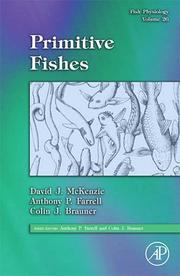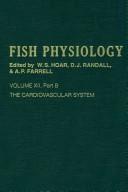| Listing 1 - 10 of 20 | << page >> |
Sort by
|
Book
ISBN: 012374542X 0123745454 9780123745439 0123745438 9780123745422 9780123745453 0123745446 9780123745446 Year: 2011 Publisher: London: Academic press,
Abstract | Keywords | Export | Availability | Bookmark
 Loading...
Loading...Choose an application
- Reference Manager
- EndNote
- RefWorks (Direct export to RefWorks)
Digital
Year: 2005 Publisher: Amsterdam ;Boston Elsevier
Abstract | Keywords | Export | Availability | Bookmark
 Loading...
Loading...Choose an application
- Reference Manager
- EndNote
- RefWorks (Direct export to RefWorks)
Devoted to fishes of high latitudes (Arctic and Antarctic). This book includes themes such as: the uniqueness of the physiology of fishes that live in cold polar environments, an analysis of physiological patterns exemplified by fishes that live poles apart, and how fishes differ from fishes living in more temperate and tropical habitats.
Book
ISBN: 1282168010 9786612168017 0080877990 0123746329 9780080877990 9780123746320 Year: 2009 Publisher: London : Academic Press,
Abstract | Keywords | Export | Availability | Bookmark
 Loading...
Loading...Choose an application
- Reference Manager
- EndNote
- RefWorks (Direct export to RefWorks)
Periods of environmental hypoxia (Low Oxygen Availability) are extremely common in aquatic systems due to both natural causes such as diurnal oscillations in algal respiration, seasonal flooding, stratification, under ice cover in lakes, and isolation of densely vegetated water bodies, as well as more recent anthropogenic causes (e.g. eutrophication). In view of this, it is perhaps not surprising that among all vertebrates, fish boast the largest number of hypoxia tolerant species; hypoxia has clearly played an important role in shaping the evolution of many unique adaptive strategies. These
Fishes -- Periodicals. --- Fishes -- Physiology -- Periodicals. --- Fishes -- Physiology. --- Fishes. --- Hypoxia (Water). --- Vertebrates --- Zoology --- Health & Biological Sciences --- Fishes --- Hypoxia (Water) --- Adaptation. --- Physiology. --- Hypoxia in water --- Water --- Anoxic zones --- Dissolved oxygen --- 591.125 --- 591.1.044 --- 597 --- 597 Pisces. Fishes. Ichthyology --- Pisces. Fishes. Ichthyology --- Respiration by branchiae (gills) --- Effects of the physical and chemical factors of the environment on cells and organisms. Osmosis. Tropisms in general. Heliotropism. Phototropism. Effect of poisons. Barometric pressure

ISBN: 1281028800 9786611028800 0080549527 0123736714 9780080549521 9780123736710 9781281028808 6611028803 Year: 2007 Publisher: Amsterdam Boston Elsevier/Academic Press
Abstract | Keywords | Export | Availability | Bookmark
 Loading...
Loading...Choose an application
- Reference Manager
- EndNote
- RefWorks (Direct export to RefWorks)
Primitive fishes are a relatively untapped resource in the scientific search for insights into the evolution of physiological systems in fishes and higher vertebrates. Volume 26 in the Fish Physiology series presents what is known about the physiology of these fish in comparison with the two fish groups that dominate today, the modern elasmobranchs and the teleosts. Chapters include reviews on what is known about cardiovascular, nervous and ventilatory systems, gas exchange, ion and nitrogenous waste regulation, muscles and locomotion, endocrine systems, and reproduction. Editors prov
Fishes --- Living fossils. --- Physiology. --- Evolution. --- Fossils, Living --- Organisms --- 597.2 --- 597.3 --- 597.4 --- 591.1 --- 597.3 Elasmobranchii (Plagiostomata). Cartilaginous fishes. Selachii. Sharks etc. --- Elasmobranchii (Plagiostomata). Cartilaginous fishes. Selachii. Sharks etc. --- 597.2 Cyclostomata (Marsipobranchii). Lampreys. Hagfishes --- Cyclostomata (Marsipobranchii). Lampreys. Hagfishes --- 591.1 Animal physiology --- Animal physiology --- 597.4 Ganoidei --- Ganoidei

ISBN: 012350435X 0123504368 9786611743697 1281743690 0080585353 9786611713409 1281713406 0080585361 9780123504364 9780080585352 9780080585369 9780123504357 Year: 1992 Publisher: San Diego : Academic Press,
Abstract | Keywords | Export | Availability | Bookmark
 Loading...
Loading...Choose an application
- Reference Manager
- EndNote
- RefWorks (Direct export to RefWorks)
This book and its companion, Fish Physiology, Volume 12, Part B, are the first major syntheses of recent advances, general concepts, and species diversity of fish in almost 25 years. It provides broad coverage of the major aspects of cardiovascular physiology and is a definitive sourcebook for the field. This book discusses the special design of the venous system in aquatic vertebrates, reviews the nature of the secondary circulation in fish, and discusses the probable absence of the lymphatic system. It is of value to teachers in comparative physiology as well as to the researcher.
597 --- 591.41 --- 591.11 --- 591.11 Blood. Body fluids in general. Circulation --- Blood. Body fluids in general. Circulation --- 591.41 Circulatory organs. Circulatory system. Angiology --- Circulatory organs. Circulatory system. Angiology --- 597 Pisces. Fishes. Ichthyology --- Pisces. Fishes. Ichthyology --- Fishes --- Zoology. --- Biology --- Natural history --- Animals --- Physiology. --- Cardiovascular system.
Book
ISBN: 1306189187 9781306189187 9780123982544 0123982545 0123982553 Year: 2014 Publisher: London : Academic Press,
Abstract | Keywords | Export | Availability | Bookmark
 Loading...
Loading...Choose an application
- Reference Manager
- EndNote
- RefWorks (Direct export to RefWorks)
Fish Physiology: Organic Chemical Toxicology of Fishes discusses the different types of organic chemical contaminants and their respective toxic effects in fish. The book also covers the detection of dissolved organic compounds and methods to assess organic toxicity. Substances addressed in this book include organometallics, hydrocarbons, endocrine disrupting compounds (EDCs), insecticides, herbicides, and pharmaceuticals. Fish are exposed to an ever-increasing array of organic chemicals that find their way into rivers and oceans. Some of these compounds are no longer being pr
Fishes --- Poisonous fishes --- Ciguatera --- Ichthyism --- Ichthyosarcotoxism --- Fishes, Effect of water pollution on --- Fish kills --- Effect of water pollution on. --- Toxicology. --- Toxicology --- Organic water pollutants. --- Physiology.
Multi
ISBN: 9780123972323 0123972329 9781283959049 1283959046 Year: 2013 Publisher: Oxford ;Waltham, MA Academic Press
Abstract | Keywords | Export | Availability | Bookmark
 Loading...
Loading...Choose an application
- Reference Manager
- EndNote
- RefWorks (Direct export to RefWorks)
The need for ion and water homeostasis is common to all life. For fish, ion and water homeostasis is an especially important challenge because they live in direct contact with water and because of the large variation in the salt content of natural waters (varying by over 5 orders of magnitude). Most fish are stenohaline and are unable to move between freshwater and seawater. Remarkably, some fishes are capable of life in both freshwater and seawater. These euryhaline fishes constitute an estimated 3 to 5% of all fish species. Euryhaline fishes represent some of the most iconic and interesti
Fishes --- Physiology. --- Adaptation. --- Osmoregulation.
Digital
ISBN: 1306189187 9781306189187 9780123982544 0123982545 Year: 2014 Publisher: Amsterdam ;Boston Elsevier, AP
Abstract | Keywords | Export | Availability | Bookmark
 Loading...
Loading...Choose an application
- Reference Manager
- EndNote
- RefWorks (Direct export to RefWorks)
Digital
ISBN: 9780080549521 0080549527 1281028800 9781281028808 9786611028800 6611028803 Year: 2007 Publisher: Boston Elsevier/Academic Press
Abstract | Keywords | Export | Availability | Bookmark
 Loading...
Loading...Choose an application
- Reference Manager
- EndNote
- RefWorks (Direct export to RefWorks)
A systems approach to understanding the evolution of fish species.
Digital
ISBN: 9780080877990 0080877990 Year: 2009 Publisher: Boston Academic Press
Abstract | Keywords | Export | Availability | Bookmark
 Loading...
Loading...Choose an application
- Reference Manager
- EndNote
- RefWorks (Direct export to RefWorks)
Periods of environmental hypoxia (Low Oxygen Availability) are extremely common in aquatic systems due to both natural causes such as diurnal oscillations in algal respiration, seasonal flooding, stratification, under ice cover in lakes, and isolation of densely vegetated water bodies, as well as more recent anthropogenic causes (e.g. eutrophication). In view of this, it is perhaps not surprising that among all vertebrates, fish boast the largest number of hypoxia tolerant species; hypoxia has clearly played an important role in shaping the evolution of many unique adaptive strategies. These unique adaptive strategies either allow fish to maintain function at low oxygen levels, thus extending hypoxia tolerance limits, or permit them to defend against the metabolic consequences of oxygen levels that fall below a threshold where metabolic functions cannot be maintained. The aim of this volume is two-fold. First, this book will review and synthesize the adaptive behavioural, morphological, physiological, biochemical, and molecular strategies used by fish to survive hypoxia exposure and place them within an environmental and ecological context. Second, through the development of a synthesis chapter this book will serve as the cornerstone for directing future research into the effects of hypoxia exposures on fish physiology and biochemistry. Key Features: The only single volume available to provide an in-depth discussion of the adaptations and responses of fish to environmental hypoxia. Reviews and synthesizes the adaptive behavioural, morphological, physiological, biochemical, and molecular strategies used by fish to survive hypoxia exposure. Includes discussion of the evolutionary and ecological consequences of hypoxia exposure in fish.
| Listing 1 - 10 of 20 | << page >> |
Sort by
|

 Search
Search Feedback
Feedback About UniCat
About UniCat  Help
Help News
News